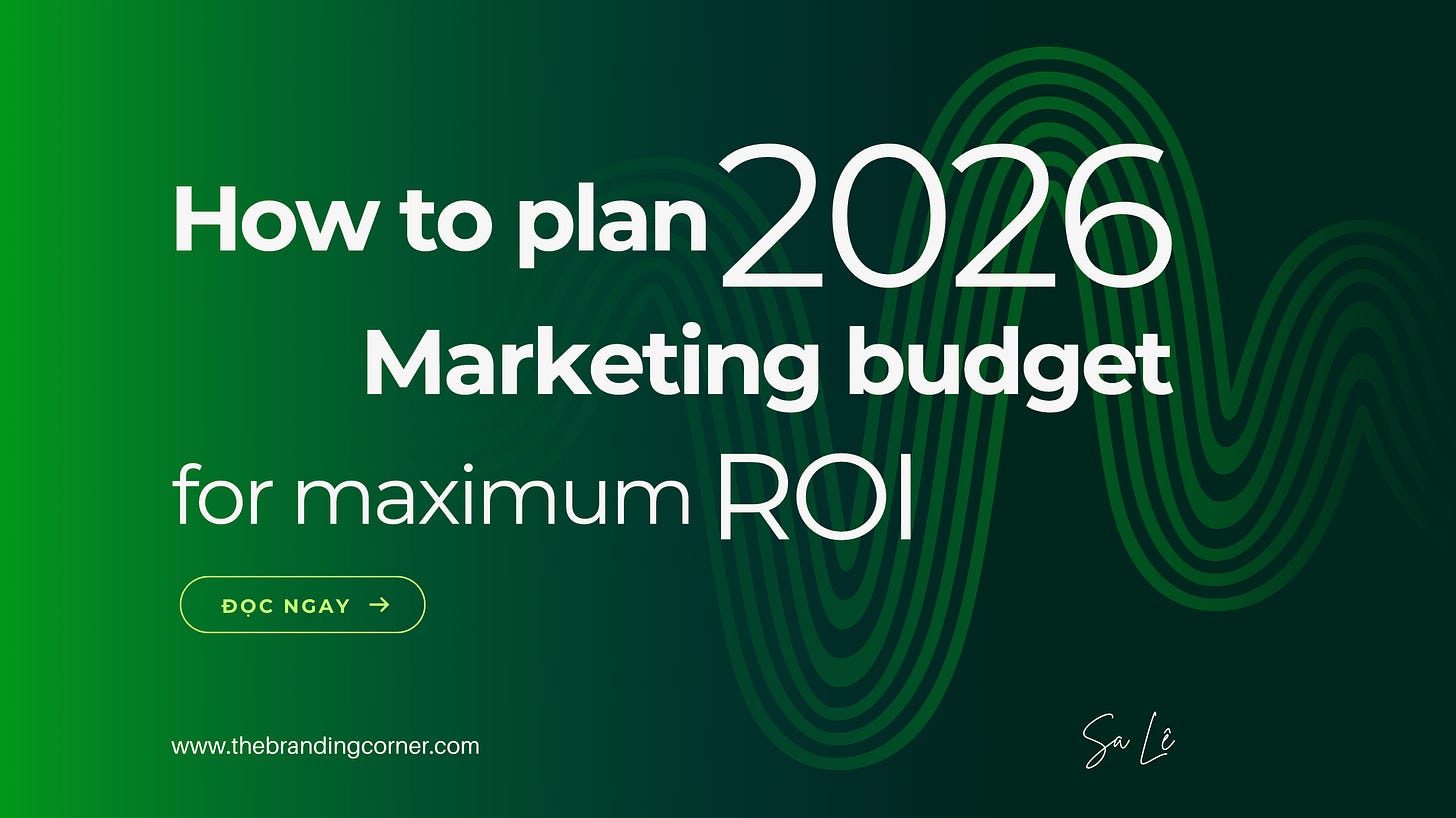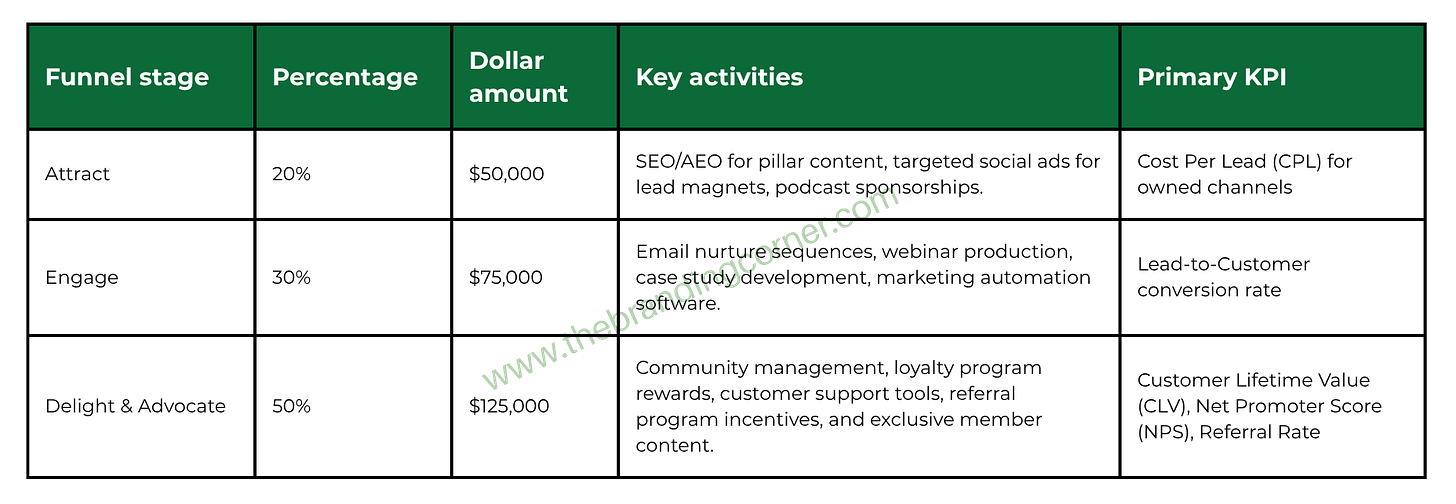How to plan a 2026 Marketing budget for maximum ROI
Is your 2025 marketing budget ready for 2026? This post offers a framework to realign spending, focusing on high-ROI assets like owned channels, AEO, and AI tools.
Why your 2025 budget model is a ticking time bomb
As a marketing leader or small business owner, you are currently planning for 2026 while navigating the most challenging strategic landscape in a generation. You are caught between persistent economic uncertainty demanding ruthless efficiency and the profound technological disruption of generative AI. In this environment, the traditional approach of simply adding 10% to last year’s budget is not just outdated; it is a direct threat to your company’s long-term viability.
The old playbook, often a simple allocation like 70% to paid ads and 30% to content, is fundamentally broken. Its core assumptions have collapsed under the weight of three market-altering trends:
The soaring cost of attention: The price of acquiring customers through digital advertising is climbing at an unsustainable rate. Average Customer Acquisition Cost (CAC) for e-commerce, for example, now stands at approximately $78, a staggering 40% increase from just two years prior. Businesses are paying significantly more to acquire each new customer as ad auctions become hyper-competitive.
The collapse of free reach: Simultaneously, the organic visibility that once justified heavy investment in “rented land” (social media platforms) has all but vanished. The average organic reach for a Facebook Page post has plummeted to between 2.6% and 5.9%. This dynamic creates a vicious cycle: as organic reach falls, brands are forced into the “pay-to-play” ecosystem, which further increases competition and drives CAC even higher.
The rise of new gatekeepers: The very way users find information is being re-architected. AI-powered “Answer Engines” (like Perplexity and Google’s AI Overviews) are replacing traditional search results. In this new paradigm, ranking number one is irrelevant. The only thing that matters is being the authoritative source cited in the AI’s answer, which demands a fundamentally different, long-term investment.
This guide provides a practical, data-driven framework for this necessary strategic pivot. It outlines where to make decisive cuts, where to double down on investment, and how to build a 2026 budget that creates defensible, long-term assets rather than just short-term visibility. The objective is to shift from renting audiences to owning relationships.
1. The “owned asset” portfolio: Where to double down in 2026
To build a resilient strategy, your 2026 budget must be reallocated toward creating appreciating assets that your business owns and controls. These are not expenses. They are capital investments in your company’s future.
Investment 1: The “owned channel” fortress (Community & Newsletter)
The rationale: An owned channel is the only marketing environment where you have a direct, unfiltered line of communication with your audience, bypassing unpredictable algorithms. The return is unparalleled. Email marketing consistently delivers an average ROI of $36- $42 per $1 spent. Beyond ROI, branded online communities provide immense strategic value. Research shows 67% of businesses use their communities as a primary source for new product development and market research, effectively turning a marketing channel into an R&D department.
Budgeting:
Platforms: Allocate funds for professional tools. For communities, Circle.so (starting at $89/mo) offers a robust suite for courses, events, and discussions. For newsletters, ConvertKit (Kit) (with a 3.5% transaction fee) is often a more scalable long-term choice for SMBs than Substack (which takes a 10% cut), as it offers superior automation and segmentation.
Human capital: This is the most critical part. Do not just budget for the software, but budget for the people. This includes dedicated community managers, expert content creators, and event moderators needed to foster the engagement that makes your ecosystem indispensable.
Investment 2: The “authority” engine (AEO, E-E-A-T, and proprietary data)
The rationale: As AI-powered “Answer Engines” become the primary interface for discovery, success is no longer about ranking, but it’s about being cited. This makes establishing E-E-A-T (Experience, Expertise, Authoritativeness, and Trustworthiness) a mission-critical, budget-level priority. Your content must be so credible that AI models have no choice but to rely on it.
Budgeting:
Subject Matter Experts (SMEs): Allocate funds to collaborate with, interview, or hire credentialed professionals. This investment elevates your content from a commodity to a citable asset. This includes creating detailed author pages with biographies and credentials, which directly signals expertise to search engines.
Proprietary data creation: This is one of the most powerful ways to build a competitive moat. Budget for activities that generate unique, citable data. This could be conducting industry surveys, analyzing your company’s internal data to reveal trends, or commissioning original research.
Technical AEO: Earmark a portion of the budget for the technical implementation required to communicate your authority to machines. This involves using robust schema markup (e.g.,
Organization,Person,Article) to build a clear “entity graph” that allows AI models to understand who you are, what you do, and why you are a trustworthy source.
Investment 3: The “efficiency” engine (AI & Automation Tools)
The rationale: The purpose of investing in marketing technology in 2026 is not to replace your most talented people, but to augment them. Automation and AI should be deployed to eliminate low-value, repetitive tasks (like data entry, report generation, or first drafts), thereby freeing your human team to focus on high-impact activities like strategy, creative development, and building customer relationships.
Budgeting:
AI content assistants: Allocate funds for tools that accelerate research and drafting. For teams focused on long-form SEO content, Jasper (from $39/mo) is a powerful option. For those prioritizing a collaborative approach, Claude is an excellent choice.
Social media schedulers: To efficiently distribute your high-value content, budget for a tool like Buffer (starting around $5/mo per channel), which is ideal for SMBs.
CRM & automation: A centralized platform is essential. For businesses seeking an all-in-one solution, HubSpot is the market leader. For SMBs focused on email and simple automation, MailerLite provides a generous free plan.
These three investment pillars are not separate. They form a self-reinforcing growth system. An engaged community provides the zero-party data and real-world questions that fuel your authority engine. AI tools then enable your team to create authoritative content at scale and manage the community that started the cycle.
2. The strategic divestment: Where to cut and reallocate
Effective budgeting is as much about what you stop funding as what you start. This is about disciplined reallocation from low-leverage, high-risk activities to the long-term assets detailed above.
Area 1: Over-reliance on “rented land” (mass social media reach)
The problem: Pouring money into boosting posts for vanity metrics like “likes” or “reach,” without a clear strategy to convert that attention into an owned asset, is financially indefensible. You are paying a toll to a platform that owns the customer relationship and can change the terms at any moment. This is a high-risk, low-equity activity.
The actionable pivot:
Cut: Drastically reduce the budget allocated to boosting posts for on-platform engagement metrics. Stop measuring success by the number of followers or likes.
Reallocate: Reframe your social media budget as a customer acquisition cost for your owned channels. Every social media ad and organic post should have one primary goal: to drive traffic off the platform and onto a landing page for your newsletter or community. Measure its success by the Cost Per Lead (CPL) for your email list.
Area 2: The content commodity trap (low-quality, high-volume production)
The problem: Generative AI can now produce “average,” keyword-stuffed blog posts in seconds for virtually zero cost. This has completely commoditized the low end of the content market. In 2026, paying humans for this type of generic, “me-too” content is a profound waste of resources. This low-quality content is not just invisible. It’s a strategic liability that signals a lack of authority.
The actionable pivot:
Cut: Eliminate the entire budget for high-volume, low-depth content. Stop commissioning generic articles that offer no unique perspective.
Reallocate: Consolidate that freed-up capital and reinvest it directly into your “Authority Engine.” Instead of spending $5,000 on ten generic blog posts, allocate that same $5,000 to producing one definitive, 4,000-word pillar article. This reallocated budget should cover SME interviews, proprietary data generation, and technical AEO. This strategic shift from quantity to quality is a fundamental requirement for survival.
3. A modern budgeting blueprint for 2026
With a clear understanding of where to invest and divest, here are two frameworks to structure your 2026 budget.
Model 1: The 70/20/10 Rule, Revised for the AI era. This classic framework remains a powerful tool for balancing risk, but its components must be redefined.
70% - Proven core engines: This majority of your budget funds your most predictable, highest-ROI activities. In 2026, this should be dominated by your owned assets: your email newsletter, high-intent Google Ads, and core blog content.
20% - Strategic pivots & growth bets: This is your investment in the future. This is where the budget for building your “Owned Channel Fortress” and “Authority Engine” resides, funding your first branded community or proprietary data report.
10% - High-risk experiments: Your R&D fund. This could be a pilot campaign on a new AI tool or an experimental content format like an interactive calculator.
Model 2: Budgeting by the “Experience Funnel” (The flywheel model). The traditional linear funnel is flawed because it over-invests in acquisition and ignores the post-purchase experience. A modern “flywheel” model, where delighted customers become your marketing engine, requires a radical budget reallocation.
Attract (20%): A smaller, efficient budget focused on bringing the right people into your ecosystem (e.g., via AEO and lead magnets).
Engage (30%): Nurturing the relationships you’ve initiated with high-value, mid-funnel content (webinars, case studies) and personalization.
Delight & advocate (50%): The largest portion. This is a direct investment in lowering future CAC. This budget funds exceptional customer support, loyalty programs, dedicated community management, and referral incentives.
This model invests heavily in the “Delight & Advocate” stage to create a compounding growth loop. Existing customers generate new, high-quality, low-cost customers through word-of-mouth, reducing dependency on expensive top-of-funnel advertising. This is not a cost center. It is an investment in a more profitable and sustainable acquisition model.
Conclusion
Your 2026 marketing budget is far more than a spreadsheet. It is a clear and powerful statement about your strategy for navigating the future. It reflects a fundamental choice: to continue renting short-term attention on volatile platforms, or to begin owning long-term, defensible assets that generate compounding returns.
The path to maximizing ROI in this new era is clear. It requires a disciplined reallocation of resources away from the collapsing models of the past and a decisive investment in the pillars of a modern marketing strategy: owned channels that give you direct access, an authority engine that makes you the definitive source, and an efficiency engine that empowers your team.
Stop funding channels that hold your audience hostage. Start investing in the assets you own. When you look at your proposed 2026 budget, does it reflect a strategy to survive the next 12 months or to thrive for the next decade?






